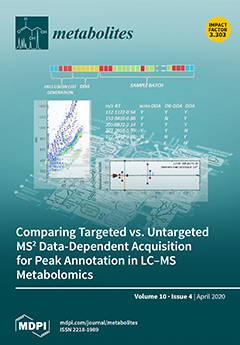Open AccessArticle
The Urinary Metabolome of Healthy Newborns
by
Yamilé López-Hernández, Juan José Oropeza-Valdez, Jorge O. Blanco-Sandate, Ana Sofia Herrera-Van Oostdam, Jiamin Zheng, An Chi Guo, Victoria Lima-Rogel, Rahmatollah Rajabzadeh, Mariana Salgado-Bustamante, Jesus Adrian-Lopez, C. G. Castillo, Emilia Robles Arguelles, Joel Monárrez-Espino, Rupasri Mandal and David S. Wishart
Cited by 20 | Viewed by 6318
Abstract
The knowledge of normal metabolite values for neonates is key to establishing robust cut-off values to diagnose diseases, to predict the occurrence of new diseases, to monitor a neonate’s metabolism, or to assess their general health status. For full term-newborns, many reference biochemical
[...] Read more.
The knowledge of normal metabolite values for neonates is key to establishing robust cut-off values to diagnose diseases, to predict the occurrence of new diseases, to monitor a neonate’s metabolism, or to assess their general health status. For full term-newborns, many reference biochemical values are available for blood, serum, plasma and cerebrospinal fluid. However, there is a surprising lack of information about normal urine concentration values for a large number of important metabolites in neonates. In the present work, we used targeted tandem mass spectrometry (MS/MS)-based metabolomic assays to identify and quantify 136 metabolites of biomedical interest in the urine from 48 healthy, full-term term neonates, collected in the first 24 h of life. In addition to this experimental study, we performed a literature review (covering the past eight years and over 500 papers) to update the references values in the Human Metabolome Database/Urine Metabolome Database (HMDB/UMDB). Notably, 86 of the experimentally measured urinary metabolites are being reported in neonates/infants for the first time and another 20 metabolites are being reported in human urine for the first time ever. Sex differences were found for 15 metabolites. The literature review allowed us to identify another 78 urinary metabolites with concentration data. As a result, reference concentration values and ranges for 378 neonatal urinary metabolites are now publicly accessible via the HMDB.
Full article
►▼
Show Figures






